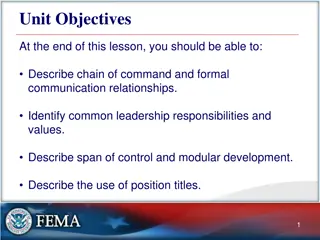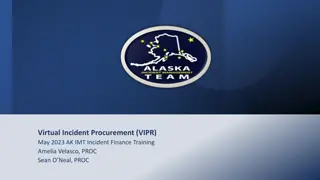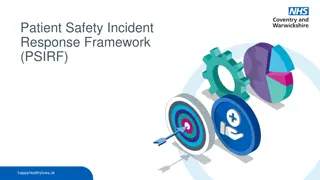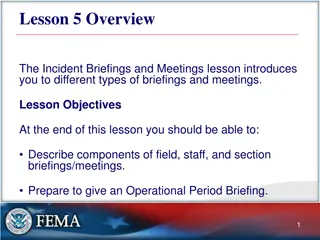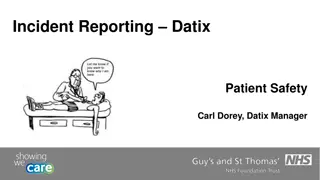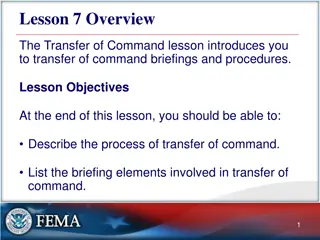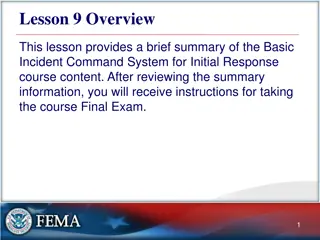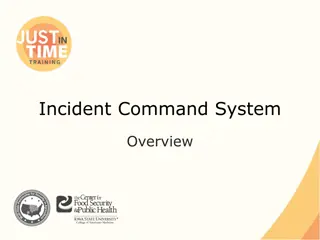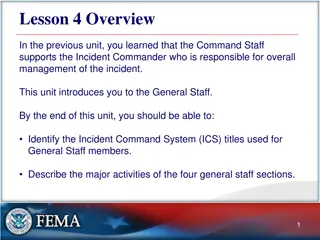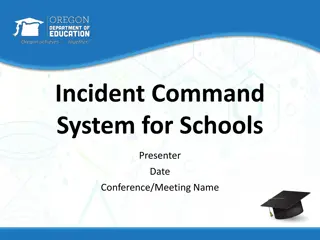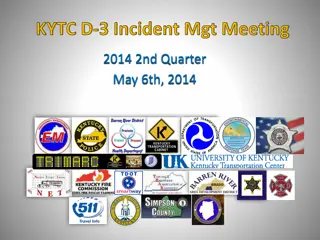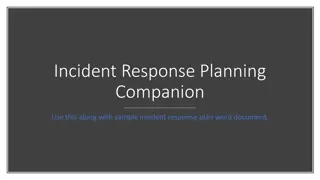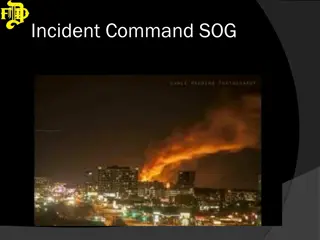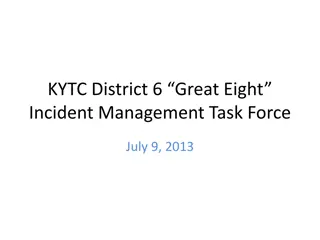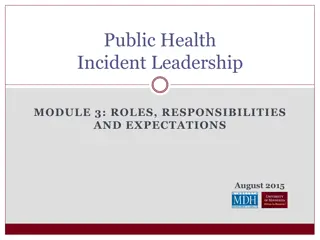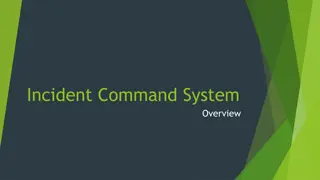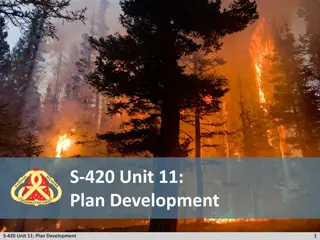Comprehensive Overview of Incident Command System for Schools
This presentation provides a detailed insight into the Incident Command System (ICS) for schools, outlining its purpose, structure, key concepts, and how individuals can fit into an ICS during emergencies. Topics covered include coordination with community partners, the importance of ICS, its structure, including the roles of incident commander, PIO, safety liaison, finance/admin, operations, planning, and logistics sections, and the functions of each section. Suitable for school administrators, emergency management personnel, and all stakeholders involved in ensuring effective incident response in educational settings.
Download Presentation

Please find below an Image/Link to download the presentation.
The content on the website is provided AS IS for your information and personal use only. It may not be sold, licensed, or shared on other websites without obtaining consent from the author.If you encounter any issues during the download, it is possible that the publisher has removed the file from their server.
You are allowed to download the files provided on this website for personal or commercial use, subject to the condition that they are used lawfully. All files are the property of their respective owners.
The content on the website is provided AS IS for your information and personal use only. It may not be sold, licensed, or shared on other websites without obtaining consent from the author.
E N D
Presentation Transcript
Incident Command System for Schools Presenter Date Conference/Meeting Name
Presentation Overview Today s Agenda Before we begin Purpose of the ICS Structure of the ICS ICS: Key Concepts How to apply the key concepts. Where you fit into an ICS Conclusion
Before We Begin Coordination With Community Partners Emergency management and first responders will be in your schools during an incident. Prior coordination with them will ensure a smooth transition during an emergency. Coordinate before an emergency happens so that first responders are not surprised by your school s structure, environment or organization. Oregon Department of Education 3
Purpose of ICS Incident Command System: Why? Inadequate management is the leading cause of incident response failures. Clear and definable command structure ensures unity of purpose during an incident. The ICS is part of the National Incident Management System part of a top-down approach. The use of ICS is a requirement for all schools and school districts receiving emergency preparedness funding. Oregon Department of Education 4
Structure of ICS Incident Command System: How it is structured. Incident Commander PIO Safety Liaison Finance/ Admin Operations Planning Logistics Oregon Department of Education 5
Structure of ICS (explained) Incident Command System: How it is structured The ICS is adaptable and scalable you only activate the sections you need. The incident commander is responsible for the work of the sections that are not independently staffed. The command staff assists and advises the incident commander. Public information officer. Safety officer. Liaison officer. The departments engage in incident response. Oregon Department of Education 6
Structure of ICS (sections) Operations Section The operations section conducts the response. Likely the first section that will be set up during initial response. Logistics Section Responsible for supplying and providing function to the incident response. Responsible for communications, transportation and supply staging. Planning Section The planning section plans out the response. Coordinates with the other sections for continued response. Finance and Administration Section The finance and administration section ensures the bills get paid and people get tracked. Oregon Department of Education 7
ICS: Key Concepts for Schools Common Terminology Use plain English and avoid jargon. Unity of Command Each person should only report to one supervisor to avoid confusion. Span of Control A concept that describes the appropriate ratio of people supervised per supervisor. Unified Command When multiple organizations work together with independent commands they should work together to avoid conflicts of command.
Common Terminology First: speak clearly. Use plain English when communicating. First responders might not know what an IEP is, but they might know what you mean if you say a student has a Personal Emergency Evacuation Plan . Second: Standardize with simple language. School districts should set the policy for emergency response language for all schools. Make your emergency drill language standard for all schools. Share your response language and procedures with your first responders. Hold! in your room or area. Clear the halls. Secure! Get inside. Lock outside doors. Lockdown! Locks, lights, out of sight Shelter! Hazard and safety strategy. Evacuate! (A location may be Oregon Department of Education specified) 9
Unity of Command People should only report to one person! Multiple supervisors for individuals can end up confusing a response effort with contradictory instruction. Ensure your teachers and staff know who their one person is who they report to during an emergency. Oregon Department of Education 10
Span of Control Golden Ratio: 1 to 5. Having 20 or more students in a classroom is one thing; having 20 teachers report to one assistant principle is another: don t do that! Ways to organize this: Have response teams that collect attendance or status for reporting. Organize your assembly areas by teams. English Department as one accountability team; Science Department as another Oregon Department of Education 11
Unified Command Less impactful for schools; a big deal for districts! The fire department owns the fire. You own the students. District should have a plan to coordinate their response (such as communication and reunification) in a Unified Command: Schools know how they communicate with parents. Schools know how they transport and reunify students. Oregon Department of Education 12
ICS: Keep in Mind When an ICS is established for an incident or event in a school: Know who your Incident Commander and team leads are before an incident (not always the principle). The ICS structure is different from the daily administrative structure in order to avoid confusion over whom you should take direction from. The supervisors of the Incident Command should use the correct ICS titles; these will be different from their daily school position titles. Oregon Department of Education 13
Where You Fit Into ICS Initial Response: Eventually, police, fire, emergency medical services or another external agency will manage response to the incident. The people already in the building will respond first: you! You must act as a bridge from the time of initial response until first-responders arrive. Remember: Keep the response language simple and in plain English (first responders don t know your acronyms). One person only reports to one supervisor. Don t overwhelm your team leads or supervisors! Try to keep it to five or fewer people per supervisor. Coordinate your activities with your first responders before, during and after.
Additional ICS Resources Recommended Training Resources for Schools: List of free online courses on ICS: https://www.oregon.gov/ode/schools-and- districts/grants/Documents/Office%20of%20School%20Facilities/SSEM/Training/Fre e%20Online%20Training_FEMA.pdf Federal Emergency Management Agency Resources: A brief (8-page) document that explains ICS in a school environment: https://training.fema.gov/emiweb/is/is100c/english/handouts/ics_for_schools.pdf Oregon Department of Education 15
Were Here to Help School Safety and Emergency Management: Provide support to the schools and school districts in Oregon for the development and implementation of high-quality emergency operations plans. Contact: Visit our contacts page to connect with your regional trainer. We will come to you! Oregon Department of Education 16


